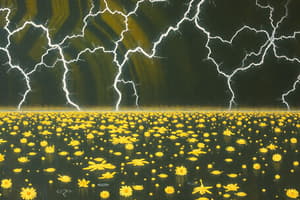Podcast
Questions and Answers
What is the charge of an electron in Coulombs?
What is the charge of an electron in Coulombs?
- – 1.6 × (10^–19)C (correct)
- 1.6 × (10^–20)C
- – 1.6 × (10^–20)C
- 1.6 × (10^–18)C
What happens when a glass rod is rubbed with silk?
What happens when a glass rod is rubbed with silk?
- No charge is transferred between the rod and the silk.
- Electrons are transferred from the rod to the silk. (correct)
- The rod and the silk become neutral.
- Electrons are transferred from the silk to the rod.
What is the property of charges that ensures that the total charge of an isolated system remains constant?
What is the property of charges that ensures that the total charge of an isolated system remains constant?
- Additivity of charges
- Attraction of unlike charges
- Repulsion of like charges
- Conservation of charge (correct)
What is the formula for the charge on a body?
What is the formula for the charge on a body?
What happens to a body when it loses some of its electrons?
What happens to a body when it loses some of its electrons?
What is the property of charges that allows us to add the charges of individual particles to find the total charge of a system?
What is the property of charges that allows us to add the charges of individual particles to find the total charge of a system?
What is the charge of an electron in coulombs?
What is the charge of an electron in coulombs?
What is the total charge of a system containing five charges +1, +2, –3, +4 and –5, in some arbitrary unit?
What is the total charge of a system containing five charges +1, +2, –3, +4 and –5, in some arbitrary unit?
What is the basis of quantisation of charge?
What is the basis of quantisation of charge?
What is conserved in an isolated system?
What is conserved in an isolated system?
Who experimentally demonstrated the quantisation of charge?
Who experimentally demonstrated the quantisation of charge?
What is the unit of charge in the International System (SI) of Units?
What is the unit of charge in the International System (SI) of Units?
Flashcards are hidden until you start studying
Study Notes
Intrinsic Property of Matter
- Charge is an intrinsic property of matter.
Frictional Charges
- Charges developed on bodies when rubbed against each other are called frictional charges.
Expression of Charge
- Charge on a body is expressed as q = ±ne, where n is an integer and e is the charge of an electron.
- Charge of an electron is e– = – 1.6 × (10^–19)C.
- Charge on a proton is e+ = + 1.6 × (10^–19)C.
Properties of Electric Charges
- Charges are additive in nature.
- Charges are conserved, meaning the total charge of an isolated system remains constant.
- Charge is quantized, meaning it comes in discrete packets (q = ne, where n is an integer).
Electrification of a Neutral Body
- To electrify a neutral body, one type of charge needs to be added or removed.
- A body can be charged positively by losing electrons or negatively by gaining electrons.
Charging of a Glass Rod
- When a glass rod is rubbed with silk, electrons are transferred from the rod to the silk cloth.
- The rod gets positively charged, and the silk gets negatively charged.
Basic Properties of Electric Charges
- Additivity of charges: total charge of a system is the algebraic sum of individual charges.
- Conservation of charge: total charge of an isolated system remains constant.
- Quantisation of charge: charge on a body is given by q = ne, where n is an integer.
Comparison with Mass
- Charge has magnitude but no direction, similar to mass.
- Mass is always positive, whereas charge can be positive or negative.
- Signs must be used when adding charges in a system.
Conservation of Charge
- Conservation of charge has been experimentally established.
- It is not possible to create or destroy net charge in an isolated system.
Quantisation of Charge
- Experimentally established that all free charges are integral multiples of a basic unit of charge (e).
- By convention, charge on an electron is –e, and that on a proton is +e.
- Quantisation of charge was first suggested by Faraday's laws of electrolysis and experimentally demonstrated by Millikan in 1912.
Studying That Suits You
Use AI to generate personalized quizzes and flashcards to suit your learning preferences.





